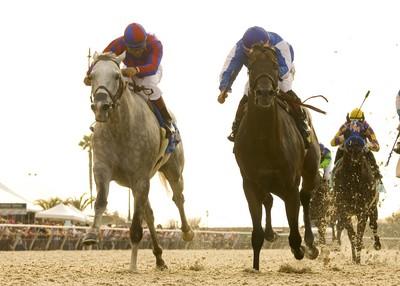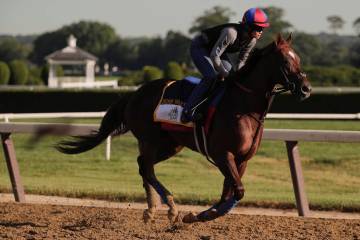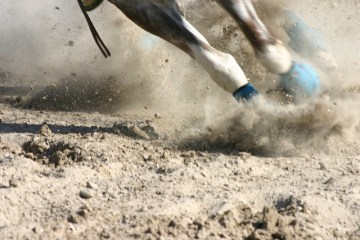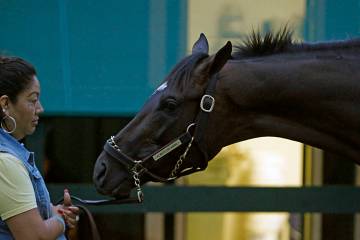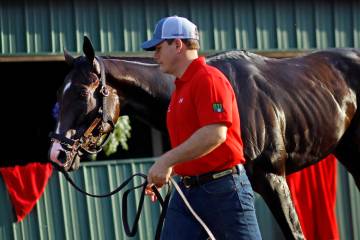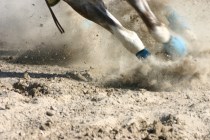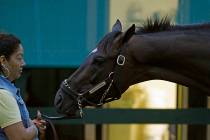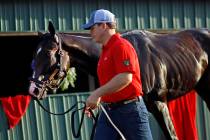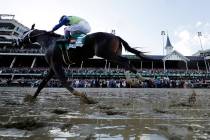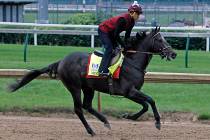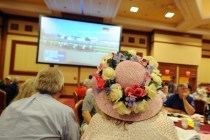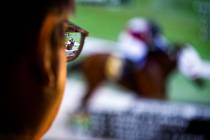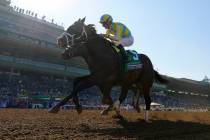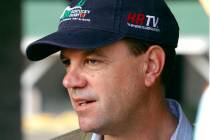Bettors agree: Track tricky
Gene Martin was doing a good job of keeping his composure, which wasn't easy given how many tickets he was shredding trying to pick a winner Monday afternoon at the Del Mar racetrack.
The Las Vegan was sitting in the back of the Texas Station race and sports book trying to get a handle on handicapping Del Mar's new Polytrack surface.
He admitted he was struggling.
"One day the speed wins, and the next day the closers win, so just when you think you've got it figured out ... ," he said while staring at his Daily Racing Form. "It's frustrating."
A few seats away, Carl Jones of Los Angeles was ready to pitch his Racing Form in the trash can. He's a speed handicapper, meaning he likes to bet horses that go right to the front and try to win wire to wire. But when it came to spotting speed at Del Mar, he wasn't having much luck.
"I'm having a tough time picking winners," he said as he played the races with brother Elberry, who lives in Las Vegas. "They're not running to form on this new track. And it's slower."
Safer, too. In its attempt to create a better environment for the horses, Del Mar spent $9 million to install Polytrack, which is a composition of sand, rubber, carpet fiber and wax. It provides more cushion than a conventional dirt track, thus making it easier on a horse's legs.
Through the meet's first two weeks, not a single horse had broken down or had to be destroyed after racing over Polytrack. Last year's meet, which was run on the dirt, saw 15 horses put down after being injured. An additional three horses were euthanized in 2006 following mishaps on Del Mar's turf course.
"The only reason we put it in was safety," said Joe Harper, Del Mar's president, CEO and general manager. "So far, knock on wood, everyone's coming back safe."
On the Polytrack, yes. On the grass, no. Three horses have been put down this year after being injured on the turf course. Yet Del Mar officials maintain their turf course is safe for horses.
"It's unfortunate anytime we lose a horse," Harper said. "But we've talked to the horsemen, and they're comfortable with the turf here."
Del Mar intended to install Polytrack a year ago but was stalled in a tangle of red tape in trying to secure the proper environmental permits. But the horsemen and jockeys say it was worth the wait.
"I like it," said Corey Nakatani, a veteran jockey who has three Del Mar riding titles and is off to a good start in 2007. "It's a fair racetrack. Horses can win on the lead, and they can win from behind.
"And the dirt clods aren't coming back at you like 90 mph fastballs."
Peter Miller, who is the leading trainer for the first two weeks of the 2007 meet, said it's not just what happens in the afternoon that matters.
"They're coming back well, both in training and in the races," Miller said of his horses. "They're coming back better than normal, and that's what it's all about."
As track superintendent, Steve Wood is responsible for maintaining the Polytrack surface. Like the horsemen and horseplayers, he's learning about the new track every day.
"It's taken some adjusting on the trainers and jockeys, but by and large, they're very pleased," Wood said. "The goal was to make it safer for the horses, and it's been 10 times better than everyone thought it would be."
The track is safe, but it's also slow. The times being run this year are a few ticks slower than races run at the same conditions in previous years. But Wood believes as the Polytrack gets more use -- broken in, so to speak -- times will quicken.
"I think it'll get a little tighter and a little faster as we race more on it," Wood said. "But I'm not worried about time. Time is for guys who are in jail."
Las Vegas horseplayer Joe Ference noticed the times are slower this year at Del Mar. He and son Bill were trying to find the speed horses who could go to the front and last, and they weren't having much success. But he wasn't necessarily blaming the Polytrack for that.
"I never considered it at all," Joe Ference said. "I look for speed. If they can run fast at Hollywood Park, they can run fast here (at Del Mar)."
Hollywood Park offers its own version of Polytrack. The recent meet was run on "Cushion Track," and Santa Anita is installing a synthetic surface for its Oak Tree Fall meet in October. In fact, all California tracks are mandated to have artificial surfaces in order for the state horse racing board to award them racing dates.
"At first, I was skeptical," Harper said when he first was approached about Polytrack a couple of years ago. "I remember other tracks that had put in artificial tracks, Remington Park's was a disaster, and I remember some other tracks tried different surfaces and they didn't work.
"But when I saw that Keeneland and Turfway liked it, that sold us."
Harper said the professional handicappers complained to him when he decided to go with the Polytrack. But he doesn't hear anyone complaining now.
"I haven't gotten any calls," he said.
Last year at Del Mar, favorites won 35.4 percent of the time, both on dirt and turf. Through two weeks of the 2007 meet, favorites are winning at a 34.5 percent clip.
Wood said the track has remained uniform for the most part. Theories suggest that once the marine layer burns off in the early afternoon and the sun hits the surface, the wax heats up and the Polytrack's consistency changes, becoming looser.
"There may be some truth to that," Wood said. "We're still learning as we go along. But we're really not needing to do much, if anything, to the track.
"We do some things maintenance-wise, but there isn't much that we really do. Just groom it before the morning works and leave it alone. No water. Nothing."
It's a radical departure from last year, when Del Mar used 75,000 gallons of water daily in an attempt to maintain the old dirt track.
Still, betting the races at Del Mar never has been more of a guessing game.
Even though the Racing Form publishes workout information for Del Mar's new surface and the past performance lines for the horses entered indicate whether they have raced on Polytrack elsewhere, horseplayers are struggling to get a handle on the new surface.
"I can see it being easy for the horses," Bill Ference said, "but it's not as easy for the horseplayer."
PATIENCE AMONG VIRTUES FOR DEL MAR BETTING When it comes to handicapping horse racing, every bettor has a theory in plotting strategy. But how do horseplayers adjust when something new is thrown at them? In the case of Del Mar's new Polytrack surface, many of the old theories regarding the seaside racetrack near San Diego might as well be tossed into the Pacific Ocean because they no longer seem to apply. Inside speed, saving ground, front-runners lasting in route races of a mile or longer -- all seem to be inconsequential to this year's meet. Richard Eng, the Review-Journal's horse racing columnist and public handicapper, said while the meet might be only two weeks old, patterns regarding handicapping Del Mar have surfaced. "Anyone who attacked Del Mar with the same knowledge of Keeneland and Arlington (two other Polytrack racetracks) probably did pretty well," Eng said. "Closers appear to be dominating, and for some reason, saving ground on the Polytrack doesn't seem to matter. I've seen horses win that were five or six wide and still drawing off. "The percentage of the favorites that are winning this year is comparable to last year, so that's an indication the fans aren't being fooled. They seem to have a pretty good handle on it." Eng had a few suggestions for handicappers who are struggling to pick a winner at Del Mar this year: • "Pay attention to the workout lines in the Racing Form," he said. "Horses that train over the Polytrack at Del Mar and like it seem to have an advantage over those who don't." • "Horses shipping in from places like Kentucky, New York and Florida should not be ignored," Eng said. "They seem to have a little more class in their corner. "I don't know if it's because California has slipped a little in terms of overall quality, but don't be afraid to bet a horse from out of town. It's not as intimidating to ship in to Del Mar as it used to be." • "Look for jockeys who are willing to be patient," Eng said. "Del Mar's surface is slower than in the past, so it's more of a thinking man's game out there. Guys like Mike Baze, (Jose) Valdivia, Joe Talamo, Corey Nakatani and Victor Espinoza are winning a lot of the races because they're patient on their horses." STEVE CARP/REVIEW-JOURNAL



